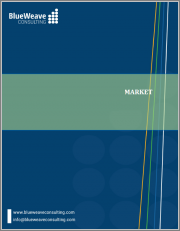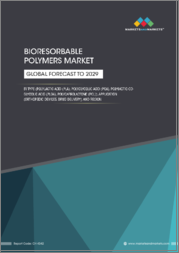
|
시장보고서
상품코드
1274836
세계의 생체흡수성 폴리머 시장 : 유형별, 용도별, 지역별 - 시장 규모, 점유율, 동향 분석, 기회, 예측(2019-2029년)Bioresorbable Polymers Market - Global Size, Share, Trend Analysis, Opportunity and Forecast Report, 2019-2029, Segmented By Type (Polylactic Acid, Polyglycolic Acid, Polylactic-co-Glycolic Acid, Polycaprolactone ); By Application ; By Region |
||||||
세계의 생체흡수성 폴리머 시장 규모는 2022년 4억 2,828만 달러에서 2029년까지 6억 8,523만 달러에 달하며, 2023-2029년의 예측 기간 중 10.85%의 CAGR로 크게 성장할 것으로 예측되고 있습니다.
체내에서 안전하게 흡수되는 의료기기에 대한 수요 증가, 의료 종사자 및 환자에서 이러한 재료의 이점에 대한 인식의 향상 등이 세계 생체흡수성 폴리머 시장의 주요 성장 촉진요인입니다. 그러나 기존 폴리머와 비교하여 생체흡수성 폴리머의 제조 비용이 높은 것, 생체흡수성 폴리머의 원재료가 한정되어 있는 것이 분석 기간중 세계 생체흡수성 폴리머 시장의 성장을 방해할 전망입니다.
세계의 생체흡수성 폴리머 시장에 대해 조사분석했으며, 시장 인사이트, 부문별·지역별 시장 분석, 경쟁 구도, 주요 기업의 개요 등의 정보를 제공하고 있습니다.
목차
제1장 조사 프레임워크
제2장 주요 요약
제3장 세계의 생체흡수성 폴리머 시장 인사이트
- 업계 밸류체인 분석
- DROC 분석
- 성장 촉진요인
- 억제요인
- 기회
- 과제
- 기술 진보/최근 개발
- 규제 프레임워크
- Porter's Five Forces 분석
제4장 세계의 생체흡수성 폴리머 시장 개요
- 시장 규모와 예측(2019-2029년)
- 금액별
- 시장 점유율과 예측
- 유형별
- 폴리유산(PLA)
- 폴리글리콜산(PGA)
- 폴리유산 - 글리콜산 모두산(PLGA)
- 폴리카프로락톤(PCL)
- 기타
- 용도별
- 약물전달
- 정형외과 용기도구
- 기타
- 지역별
- 북미
- 유럽
- 아시아태평양(APAC)
- 라틴아메리카(LATAM)
- 중동 및 아프리카(MEA)
제5장 북미의 생체흡수성 폴리머 시장
- 시장 규모와 예측(2019-2029년)
- 금액별
- 시장 점유율과 예측
- 유형별
- 용도별
- 국가별
- 미국
- 캐나다
제6장 유럽의 생체흡수성 폴리머 시장
- 시장 규모와 예측(2019-2029년)
- 금액별
- 시장 점유율과 예측
- 유형별
- 용도별
- 국가별
- 독일
- 영국
- 이탈리아
- 프랑스
- 스페인
- 벨기에
- 러시아
- 네덜란드
- 기타 유럽
제7장 아시아태평양의 생체흡수성 폴리머 시장
- 시장 규모와 예측(2019-2029년)
- 금액별
- 시장 점유율과 예측
- 유형별
- 용도별
- 국가별
- 중국
- 인도
- 일본
- 한국
- 호주·뉴질랜드
- 인도네시아
- 말레이시아
- 싱가포르
- 베트남
- 기타 아시아태평양
제8장 라틴아메리카의 생체흡수성 폴리머 시장
- 시장 규모와 예측(2019-2029년)
- 금액별
- 시장 점유율과 예측
- 유형별
- 용도별
- 국가별
- 브라질
- 멕시코
- 아르헨티나
- 페루
- 기타 라틴아메리카
제9장 중동 및 아프리카의 생체흡수성 폴리머 시장
- 시장 규모와 예측(2019-2029년)
- 금액별
- 시장 점유율과 예측
- 유형별
- 용도별
- 국가별
- 사우디아라비아
- 아랍에미리트
- 카타르
- 쿠웨이트
- 남아프리카공화국
- 나이지리아
- 알제리
- 기타 중동 및 아프리카
제10장 경쟁 구도
- 주요 기업·제품 리스트
- 세계의 생체흡수성 폴리머 시장 점유율 분석(2022년)
- 경쟁 벤치마킹 : 조작 파라미터별
- 주요 전략적 개발(합병·인수·제휴 등)
제11장 세계의 생체흡수성 폴리머 시장에 대한 COVID-19의 영향
제12장 기업 개요(기업 개요, 재무 매트릭스, 경쟁 구도, 주요 인재, 주요 경쟁, 연락처, 전략적 전망, SWOT 분석)
- Corbion N.V.
- Evonik Industries AG
- Foster Corporation
- KLS Martin Group
- DSM N.V.
- Poly-Med Inc.
- Ashland Global Holdings Inc.
- Mimetis Biomaterials
- Leiber GmbH
- GALAXY Polymers
- Biomerics LLC
- Solvay SA
- Merck KGaA
- Evolva Holding SA
- PolyNovo Biomaterials Pty Ltd
- 기타
제13장 주요 전략적 권장사항
제14장 조사 방법
KSA 23.05.25Global Bioresorbable Polymers Market Size Set to Cross USD 685 million by 2029.
Global bioresorbable polymers market is flourishing because of rising awareness about eco-friendly products and sustainable development, a surging demand for bioresorbable polymers in medical applications due to their biocompatibility and biodegradability, and rising popularity of implantable medical devices and drug delivery systems.
BlueWeave Consulting, a leading strategic consulting and market research firm, in its recent study, estimated the global bioresorbable polymers market size at USD 428.28 million in 2022. During the forecast period between 2023 and 2029, BlueWeave expects the global bioresorbable polymers market size to grow at a significant CAGR of 10.85% reaching a value of USD 685.23 million by 2029. Major growth drivers for global bioresorbable polymers market include an increasing demand for medical devices that can be safely absorbed by the body, as well as growing awareness about the benefits of these materials among healthcare professionals and patients. The use of bioresorbable polymers in medical applications eliminates the need for a second surgery to remove temporary implants as they can biodegrade inside the human body. It reduces the risk to the patient post-surgery, while also not posing any threat to their body. These polymers are produced by polymerizing bio-based raw materials using engineered industrial processes. The growth of the industry is being further supported by an increase in demand for products due to technological advancements, advancements in plastic materials, and the development of more sophisticated decontamination equipment. However, high production costs of bioresorbable polymers as compared to conventional polymers and limited availability of raw materials for bioresorbable polymers are anticipated to hinder the growth of global bioresorbable polymers market during the period in analysis.
Global Bioresorbable Polymers Market - Overview:
Bioresorbable polymers, also known as biodegradable or bioresorbable polymer materials, are compounds that are safely absorbed by the human body, making them highly sought after in the healthcare sector. These polymers undergo hydrolysis and gradually break down over time, resulting in safe absorption by the body without the need for removal. Polylactic acid, polyglycolic acid, and polycaprolactone are some of the most commonly used bioresorbable polymers, with applications in orthopedics, drug delivery, surgical implants, and various other healthcare uses. Manufacturers typically use vegetable oils derived from sources, such as rapeseed, sunflower corn fiber, castor, soybean, food processing waste, potato, corn, stems, paper mill sludge, livestock waste, and leaves to produce bioresorbable polymers like polysaccharides, proteins, polylactic acid, polyglycolic acid, and polycaprolactone. The bio-based content in these polymers varies depending on the type of feedstock used during manufacturing.
Impact of COVID-19 on Global Bioresorbable Polymers Market
The COVID-19 pandemic had a detrimental impact on the global bioresorbable polymers market. Due to the imposition of lockdowns and restrictions on travel and manufacturing activities, the market experienced disruptions in the supply chain, resulting in a decline in demand for bioresorbable polymers. The pandemic also led to a decrease in elective surgeries and medical procedures, which are the primary applications of bioresorbable Polymers, further affecting the market negatively. However, the demand for bioresorbable polymers witnessed an increase in applications related to the production of personal protective equipment (PPE), such as masks and gowns. The use of bioresorbable polymers in PPE production has recovered post-pandemic as a result of growing demand for sustainable and environmentally friendly materials. Despite the short-term impact of COVID-19 on the bioresorbable polymers market, the increasing focus on sustainable development and growing demand for eco-friendly products in various industries, including healthcare, is expected to drive the growth of the market during the forecast period.
Global Bioresorbable Polymers Market - By Application:
Based on application, the global bioresorbable polymers market is bifurcated into Drug Delivery and Orthopedic Devices segments. The orthopedic devices segment holds a higher share in the global bioresorbable polymers market due to the significant demand for these polymers in orthopedic surgeries. Bioresorbable polymers, such as polylactic acid (PLA), polyglycolic acid (PGA), and polycaprolactone (PCL), are commonly used to fabricate temporary implants in orthopedic surgeries, such as bone fixation and cartilage repair. These polymers can degrade over time and get absorbed by the body, eliminating the need for a second surgery to remove the implant. This not only reduces the risk of complications and infections but also eliminates the need for a second surgery, reducing costs for both patients and healthcare providers. Also, bioresorbable polymers offer superior mechanical strength and biocompatibility, making them an ideal choice for orthopedic implants.
Competitive Landscape:
Major players operating in global bioresorbable polymers market include: Corbion N.V., Evonik Industries AG, Foster Corporation, KLS Martin Group, DSM N.V., Poly-Med Inc., Ashland Global Holdings Inc., Mimetis Biomaterials, Leiber GmbH, GALAXY Polymers, Biomerics LLC, Solvay SA, Merck KGaA, Evolva Holding SA, and PolyNovo Biomaterials Pty Ltd. To further enhance their market share, these companies employ various strategies, including mergers and acquisitions, partnerships, joint ventures, license agreements, and new product launches.
The in-depth analysis of the report provides information about growth potential, upcoming trends, and statistics of Global Bioresorbable Polymers Market. It also highlights the factors driving forecasts of total market size. The report promises to provide recent technology trends in Global Bioresorbable Polymers Market and industry insights to help decision-makers make sound strategic decisions. Furthermore, the report also analyzes the growth drivers, challenges, and competitive dynamics of the market.
Table of Contents
1. Research Framework
- 1.1. Research Objective
- 1.2. Product Overview
- 1.3. Market Segmentation
2. Executive Summary
3. Global Bioresorbable Polymers Market Insights
- 3.1. Industry Value Chain Analysis
- 3.2. DROC Analysis
- 3.2.1. Growth Drivers
- 3.2.1.1. Growing demand for bioresorbable polymers in medical applications due to their biocompatibility and biodegradability
- 3.2.1.2. Increasing awareness about eco-friendly products and sustainable development
- 3.2.1.3. Rising demand for implantable medical devices and drug delivery systems
- 3.2.2. Restraints
- 3.2.2.1. High production costs of bioresorbable polymers as compared to conventional polymers
- 3.2.2.2. Limited availability of raw materials for bioresorbable polymers
- 3.2.3. Opportunities
- 3.2.3.1. Increasing investment in research and development activities for bioresorbable polymers
- 3.2.3.2. Emerging applications in other sectors such as packaging and agriculture
- 3.2.4. Challenges
- 3.2.4.1. Limited shelf life and stability of bioresorbable polymers
- 3.2.1. Growth Drivers
- 3.3. Technology Advancements/Recent Developments
- 3.4. Regulatory Framework
- 3.5. Porter's Five Forces Analysis
- 3.5.1. Bargaining Power of Suppliers
- 3.5.2. Bargaining Power of Buyers
- 3.5.3. Threat of New Entrants
- 3.5.4. Threat of Substitutes
- 3.5.5. Intensity of Rivalry
4. Global Bioresorbable Polymers Market Overview
- 4.1. Market Size & Forecast, 2019-2029
- 4.1.1. By Value (USD Million)
- 4.1.2. Market Share and Forecast
- 4.1.3. By Type
- 4.1.3.1. Polylactic Acid (PLA)
- 4.1.3.2. Polyglycolic Acid (PGA)
- 4.1.3.3. Polylactic-co-glycolic Acid (PLGA)
- 4.1.3.4. Polycaprolactone (PCL)
- 4.1.3.5. Others
- 4.1.4. By Application
- 4.1.4.1. Drug Delivery
- 4.1.4.2. Orthopedic Devices
- 4.1.4.3. Others
- 4.1.5. By Region
- 4.1.5.1. North America
- 4.1.5.2. Europe
- 4.1.5.3. Asia Pacific (APAC)
- 4.1.5.4. Latin America (LATAM)
- 4.1.5.5. Middle East and Africa (MEA)
5. North America Bioresorbable Polymers Market
- 5.1. Market Size & Forecast, 2019-2029
- 5.1.1. By Value (USD Million)
- 5.2. Market Share & Forecast
- 5.2.1. By Type
- 5.2.2. By Application
- 5.2.3. By Country
- 5.2.3.1. United States
- 5.2.3.1.1. By Type
- 5.2.3.1.2. By Application
- 5.2.3.2. Canada
- 5.2.3.2.1. By Type
- 5.2.3.2.2. By Application
6. Europe Bioresorbable Polymers Market
- 6.1. Market Size & Forecast, 2019-2029
- 6.1.1. By Value (USD Million)
- 6.2. Market Share & Forecast
- 6.2.1. By Type
- 6.2.2. By Application
- 6.2.3. By Country
- 6.2.3.1. Germany
- 6.2.3.1.1. By Type
- 6.2.3.1.2. By Application
- 6.2.3.2. United Kingdom
- 6.2.3.2.1. By Type
- 6.2.3.2.2. By Application
- 6.2.3.3. Italy
- 6.2.3.3.1. By Type
- 6.2.3.3.2. By Application
- 6.2.3.4. France
- 6.2.3.4.1. By Type
- 6.2.3.4.2. By Application
- 6.2.3.5. Spain
- 6.2.3.5.1. By Type
- 6.2.3.5.2. By Application
- 6.2.3.6. Belgium
- 6.2.3.6.1. By Type
- 6.2.3.6.2. By Application
- 6.2.3.7. Russia
- 6.2.3.7.1. By Type
- 6.2.3.7.2. By Application
- 6.2.3.8. The Netherlands
- 6.2.3.8.1. By Type
- 6.2.3.8.2. By Application
- 6.2.3.9. Rest of Europe
- 6.2.3.9.1. By Type
- 6.2.3.9.2. By Application
7. Asia-Pacific Bioresorbable Polymers Market
- 7.1. Market Size & Forecast, 2019-2029
- 7.1.1. By Value (USD Million)
- 7.2. Market Share & Forecast
- 7.2.1. By Type
- 7.2.2. By Application
- 7.2.3. By Country
- 7.2.3.1. China
- 7.2.3.1.1. By Type
- 7.2.3.1.2. By Application
- 7.2.3.2. India
- 7.2.3.2.1. By Type
- 7.2.3.2.2. By Application
- 7.2.3.3. Japan
- 7.2.3.3.1. By Type
- 7.2.3.3.2. By Application
- 7.2.3.4. South Korea
- 7.2.3.4.1. By Type
- 7.2.3.4.2. By Application
- 7.2.3.5. Australia & New Zealand
- 7.2.3.5.1. By Type
- 7.2.3.5.2. By Application
- 7.2.3.6. Indonesia
- 7.2.3.6.1. By Type
- 7.2.3.6.2. By Application
- 7.2.3.7. Malaysia
- 7.2.3.7.1. By Type
- 7.2.3.7.2. By Application
- 7.2.3.8. Singapore
- 7.2.3.8.1. By Type
- 7.2.3.8.2. By Application
- 7.2.3.9. Vietnam
- 7.2.3.9.1. By Type
- 7.2.3.9.2. By Application
- 7.2.3.10. Rest of APAC
- 7.2.3.10.1. By Type
- 7.2.3.10.2. By Application
8. Latin America Bioresorbable Polymers Market
- 8.1. Market Size & Forecast, 2019-2029
- 8.1.1. By Value (USD Million)
- 8.2. Market Share & Forecast
- 8.2.1. By Type
- 8.2.2. By Application
- 8.2.3. By Country
- 8.2.3.1. Brazil
- 8.2.3.1.1. By Type
- 8.2.3.1.2. By Application
- 8.2.3.2. Mexico
- 8.2.3.2.1. By Type
- 8.2.3.2.2. By Application
- 8.2.3.3. Argentina
- 8.2.3.3.1. By Type
- 8.2.3.3.2. By Application
- 8.2.3.4. Peru
- 8.2.3.4.1. By Type
- 8.2.3.4.2. By Application
- 8.2.3.5. Rest of LATAM
- 8.2.3.5.1. By Type
- 8.2.3.5.2. By Application
9. Middle East & Africa Bioresorbable Polymers Market
- 9.1. Market Size & Forecast, 2019-2029
- 9.1.1. By Value (USD Million)
- 9.2. Market Share & Forecast
- 9.2.1. By Type
- 9.2.2. By Application
- 9.2.3. By Country
- 9.2.3.1. Saudi Arabia
- 9.2.3.1.1. By Type
- 9.2.3.1.2. By Application
- 9.2.3.2. UAE
- 9.2.3.2.1. By Type
- 9.2.3.2.2. By Application
- 9.2.3.3. Qatar
- 9.2.3.3.1. By Type
- 9.2.3.3.2. By Application
- 9.2.3.4. Kuwait
- 9.2.3.4.1. By Type
- 9.2.3.4.2. By Application
- 9.2.3.5. South Africa
- 9.2.3.5.1. By Type
- 9.2.3.5.2. By Application
- 9.2.3.6. Nigeria
- 9.2.3.6.1. By Type
- 9.2.3.6.2. By Application
- 9.2.3.7. Algeria
- 9.2.3.7.1. By Type
- 9.2.3.7.2. By Application
- 9.2.3.8. Rest of MEA
- 9.2.3.8.1. By Type
- 9.2.3.8.2. By Application
10. Competitive Landscape
- 10.1. List of Key Players and Their Offerings
- 10.2. Global Bioresorbable Polymers Market Share Analysis, 2022
- 10.3. Competitive Benchmarking, By Operating Parameters
- 10.4. Key Strategic Developments (Mergers, Acquisitions, Partnerships, etc.)
11. Impact of Covid-19 on Global Bioresorbable Polymers Market
12. Company Profile (Company Overview, Financial Matrix, Competitive Landscape, Key Personnel, Key Competitors, Contact Address, Strategic Outlook, SWOT Analysis)
- 12.1. Corbion N.V.
- 12.2. Evonik Industries AG
- 12.3. Foster Corporation
- 12.4. KLS Martin Group
- 12.5. DSM N.V.
- 12.6. Poly-Med Inc.
- 12.7. Ashland Global Holdings Inc.
- 12.8. Mimetis Biomaterials
- 12.9. Leiber GmbH
- 12.10. GALAXY Polymers
- 12.11. Biomerics LLC
- 12.12. Solvay SA
- 12.13. Merck KGaA
- 12.14. Evolva Holding SA
- 12.15. PolyNovo Biomaterials Pty Ltd
- 12.16. Other Prominent Players
13. Key Strategic Recommendations
14. Research Methodology
- 14.1. Qualitative Research
- 14.1.1. Primary & Secondary Research
- 14.2. Quantitative Research
- 14.3. Market Breakdown & Data Triangulation
- 14.3.1. Secondary Research
- 14.3.2. Primary Research
- 14.4. Breakdown of Primary Research Respondents, By Region
- 14.5. Assumptions & Limitations
*Financial information of case of non-listed companies can be provided as per availability.
**The segmentation and the companies are subject to modifications based on in-depth secondary research for the final deliverable



















